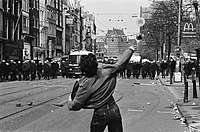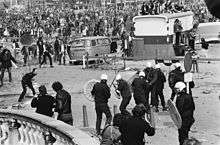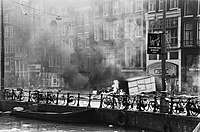Amsterdam coronation riots



The Amsterdam coronation riots (Dutch: Kroningsoproer) refers to major violence and rioting in Amsterdam, the Netherlands on the day of the coronation of Queen Beatrix, 30 April 1980. It was the biggest episode of such disturbances in the country since the end of World War II and the most significant event of the Dutch squatters' movement (Krakersrellen).
Background
Since the 1960s and 1970s, squatting became a commonplace movement in protest against the shortage of housing in Amsterdam. Many of these protesters were youngsters of the baby boom generation.[1] Some of the biggest riots were the Nieuwmarkt Riots in 1975 and the Vondelstraat Riots in March 1980, when authorities heavily responded to evict squatters from properties in the city.[1]
On 31 January, Queen Juliana of the Netherlands announced that she would abdicate in favour of her daughter, Princess Beatrix, on 30 April.
Coronation and riots

Beatrix's coronation as Queen was on 30 April 1980, and was when squatters started to riot. The protesters were rallying under the slogan Geen woning, geen kroning, which translates to 'No house, no coronation'.[2] Despite the presence of 10,000 police officers, gendarmes and some military officers, the event turned into a major clash.[3] The riots were centred around the Dam Square, where the new Queen's inauguration took place.[4] Clashes also happened in and around Blauwbrug, Rokin and Vondelstraat.[5]
One of the protesters, Karel Fassotte, claimed in an interview that apart from squatters, people taking part included ordinary students, football hooligans and others.[6]
It marked a milestone in the post-war peaceful history of the Netherlands. 600 people were wounded.[7]
Aftermath
The squatters' movement had much support for their cause beforehand, but this was depreciated following the riots. This was partly because the Dutch royal family was highly popular amongst the population, and the squatters had turned this day of coronation into one of violence.[8]
A new police leadership in Amsterdam started to forcibly evacuate squatted buildings, including through special means.[4]
In 2010, the Dutch parliament voted to ban squatting entirely.[3][9]
See also
References
- 1 2 "Amsterdam squatters and police mark 1980 riots".
- ↑ "Queen Beatrix - Historical figures - Rijksstudio - Rijksmuseum".
- 1 2 Stroobants, Jean-Pierre (20 July 2011). "Amsterdam vs. the Squatters: Evictions, Arrests and Protests" – via content.time.com.
- 1 2 Rousseaux, Xavier; Campion, Jonas (29 April 2016). "Policing New Risks in Modern European History". Springer – via Google Books.
- ↑ "Kroning 1980 vs 2013: welke muzikant werpt de eerste steen? - artikelen".
- ↑ "During the squatter riots, Karel Fassotte operated a radio jammer in order to disrupt police communications".
- ↑ "Deep-lying, even violent, divisions are a recurring theme in Dutch history - DutchNews.nl".
- ↑ "Squatting in Amsterdam - DutchAmsterdam.com". 19 January 2009.
- ↑ "Violent protests after Dutch outlaw squatting - World news - Europe - msnbc.com". 3 October 2010.